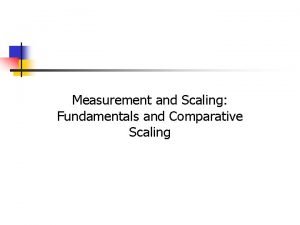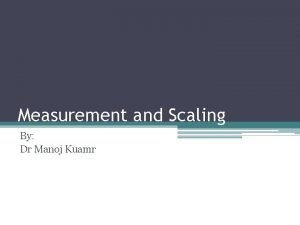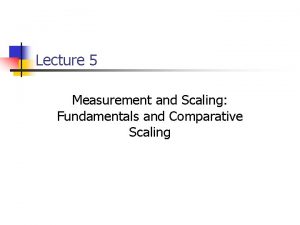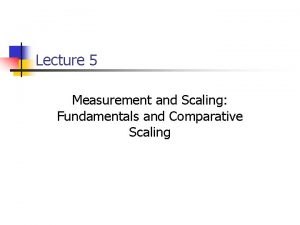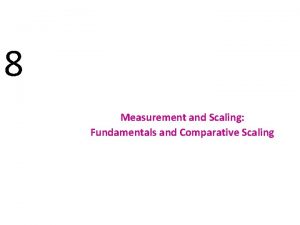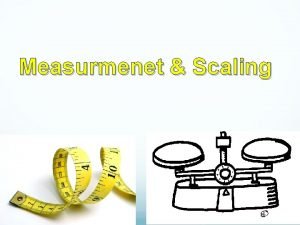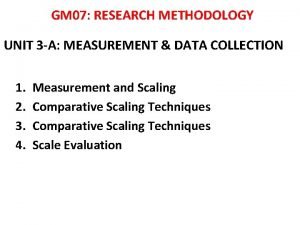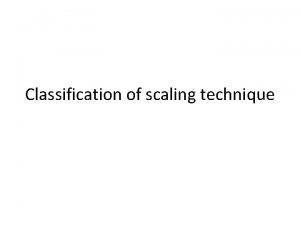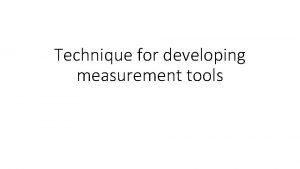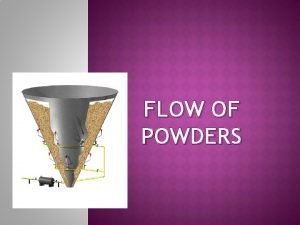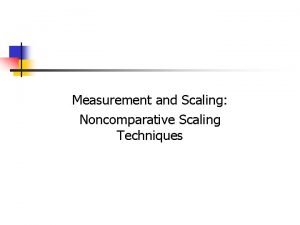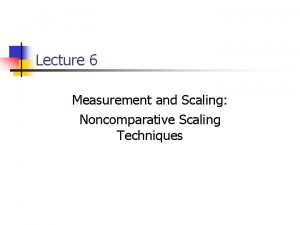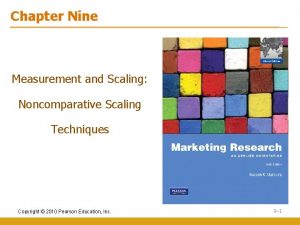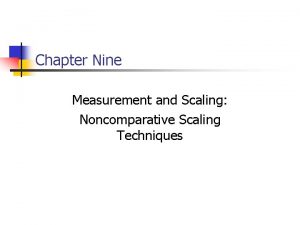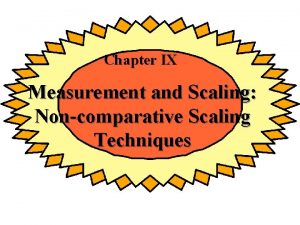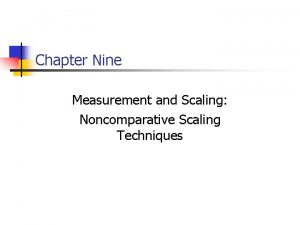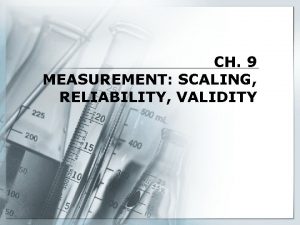9 Measurement and Scaling Noncomparative Scaling Techniques Noncomparative










- Slides: 10

9 Measurement and Scaling: Noncomparative Scaling Techniques

Noncomparative Scaling Techniques • Respondents evaluate only one object at a time, and for this reason noncomparative scales are often referred to as monadic scales. • Noncomparative techniques consist of continuous and itemized rating scales.

Figure 10. 3 A Classification of Noncomparative Rating Scales Continuous Rating Scales Semantic Differential Itemized Rating Scales Stapel Likert

Continuous Rating Scale Respondents rate the objects by placing a mark at the appropriate position on a line that runs from one extreme of the criterion variable to the other. The form of the continuous scale may vary considerably. How would you rate Sears as a department store? Version 1 Probably the worst - - - -I - - - - - - - - - - Probably the best Version 2 Probably the worst - - - -I - - - - - - - - -- - Probably the best 0 10 20 30 40 50 60 70 80 90 100 Version 3 Very bad Neither good Very good nor bad Probably the worst - - - -I - - - - - -- - - - -Probably the best 0 10 20 30 40 50 60 70 80

RATE: Rapid Analysis and Testing Environment A relatively new research tool, the perception analyzer, provides continuous measurement of “gut reaction. ” A group of up to 400 respondents is presented with TV or radio spots or advertising copy. The measuring device consists of a dial that contains a 100 -point range. Each participant is given a dial and instructed to continuously record his or her reaction to the material being tested. As the respondents turn the dials, the information is fed to a computer, which tabulates second-bysecond response profiles. As the results are recorded by the computer, they are superimposed on a video screen, enabling the researcher to view the respondents' scores immediately. The responses are also stored in a permanent data file for use in further analysis. The response scores can be broken down by categories, such as age, income, sex, or product usage.

Itemized Rating Scales • The respondents are provided with a scale that has a number or brief description associated with each category. • The categories are ordered in terms of scale position, and the respondents are required to select the specified category that best describes the object being rated. • The commonly used itemized rating scales are the Likert, semantic differential, and Stapel scales.

Likert Scale The Likert scale requires the respondents to indicate a degree of agreement or disagreement with each of a series of statements about the stimulus objects. Strongly disagree Disagree Neither agree nor disagree Agree Strongly agree 1. Sears sells high quality merchandise. 1 2 X 3 4 5 2. Sears has poor in-store service. 1 2 X 3 4 5 3. I like to shop at Sears. 1 2 3 X 4 5 • The analysis can be conducted on an item-by-item basis (profile analysis), or a total (summated) score can be calculated. • When arriving at a total score, the categories assigned to the negative statements by the respondents should be scored by reversing the scale.

Semantic Differential Scale The semantic differential is a seven-point rating scale with end points associated with bipolar labels that have semantic meaning. SEARS IS: Powerful Unreliable Modern --: --: -X-: --: Weak --: --: --: -X-: --: Reliable --: --: --: -X-: Old-fashioned • The negative adjective or phrase sometimes appears at the left side of the scale and sometimes at the right. • This controls the tendency of some respondents, particularly those with very positive or very negative attitudes, to mark the right- or left-hand sides without reading the labels. • Individual items on a semantic differential scale may be scored on either a -3 to +3 or a 1 to 7 scale.

A Semantic Differential Scale for Measuring Self- Concepts, Person Concepts, and Product Concepts 1) Rugged 2) Excitable 3) Uncomfortable 4) Dominating 5) Thrifty : ---: ---: Delicate : ---: ---: Calm : ---: ---: Comfortable : ---: ---: Submissive : ---: ---: Indulgent 6) Pleasant : ---: ---: Unpleasant 7) Contemporary : ---: ---: Obsolete 8) Organized : ---: ---: Unorganized 9) Rational : ---: ---: Emotional 10) Youthful 11) Formal 12) Orthodox 13) Complex 14) Colorless 15) Modest : ---: ---: Mature : ---: ---: Informal : ---: ---: Liberal : ---: ---: Simple : ---: ---: Colorful : ---: ---: Vain

Stapel Scale The Stapel scale is a unipolar rating scale with ten categories numbered from -5 to +5, without a neutral point (zero). This scale is usually presented vertically. SEARS +5 +4 +3 +2 +1 HIGH QUALITY -1 -2 -3 -4 X -5 +5 +4 +3 +2 X +1 POOR SERVICE -1 -2 -3 -4 -5 The data obtained by using a Stapel scale can be analyzed in the same way as semantic differential data.
